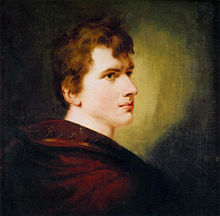The church order
The church ordinance is a story by Achim von Arnim , which appeared in the "Pocket Book for the Sociable Pleasure of the Year 1822" by Johann Friedrich Gleditsch in 1821 in Leipzig.
After the Reformation were in the now Protestant German states church orders issued for the reorganization of the Church being. Church ordinances of the 16th century regulated u. a. also questions of public morality and ordered church punishments and penalties for violations.
content
Anno 1567 in the village of Marienbild during the Gotha War : The Protestant maiden Klelie gets to know the much older Catholic Alp. Alp is a famous dowser from Salzburg. It is supposed to help the mountain being in Marienbild to flourish again. Klelie's father, the governor, quickly comes to an agreement with the miner, his old war comrade. Egenolf - that's the miner's son - and Klelie are supposed to become a couple. When Egenolf gets married, his uncle will bequeath him a beautiful property. Klelie's friend, the tenant daughter Emerenzie, is expecting a child from Egenolf. Egenolf is unable to comply with his father.
In the years after the religious peace, the Protestant clergy used the most powerful church punishments without hesitation. Emerenzie wants to escape the rant of public church penance. Old Jacob, vet and resident dowser, has a plan. The Catholic Jacob, who is tolerated in his Protestant environment, wants to attribute the child emerenzies to the maternal grandmother-to- be .
Klelie wants to become a Catholic out of love for Alp. Alp identifies himself as the Spaniard Alphons Diaz, who was well known in Germany at the time. The Inquisition had used him to execute his own brother. Alp confesses to Klelie that through her he got to know the evangelical word. With his wealth, he can offer Klelie a carefree life. But a connection between the two seems unlikely. Because the grief for the brother had become Alp Johanniter .
Emerenzie secretly gives birth to her child. The newborn dies. Emerenzie goes into the water after failing to accept the shameful church penance. The tenant's wife brings her daughter Emerenzie, believed dead, back to life.
The governor mistakenly wounds Alp fatally. The dying man carries papers with him with which he bequeaths his considerable fortune to Klelie. With the money, Klelie wants to found a monastery together with Emerenzie.
During the next service, Klelie and her father, the governor, publicly repent together on the “poor sinner's bench”. Klelie atone for having blasphemed her evangelical faith.
On the occasion of a solar eclipse, the Protestant image of Mary, Pastor Melchior, converted to the Catholic faith. His successor, the contentious Magister Cyriakus appointed by the governor, enforces the church order with rigor.
Alp, called by the sovereign to discover new ore veins, uses his divining rod to track down "spiritual treasures" that were "locked up when the monastery was looted" to the reader's surprise. From that chapel hidden in the mountain, Jacob, "an ordained priest, a missionary among the apostate Germans like Bonifacius ... once among the pagan Germans", works. Strange things happen in the hidden place. Pastor Melchior, who has disappeared from the image of Mary without a trace since the solar eclipse, emerges from a black coffin. Klelie, observer of the process, passes out. After she has regained consciousness, Alp persuades her that his church venerates idols. Alp and Klelie are in a "related faith relationship". Nobody wants to pull the other over to his religion.
reception
- In November 1821, the "Journal for Literature, Art, Luxury and Fashion" criticized the protagonists' indecision in their confessional decisions.
- The reviewer in the “ Jenaische Allgemeine Literatur-Zeitung ” is - also in November 1821 - generally not satisfied. Although the author is a “real talent”, some of the text is “embarrassing”.
- The slap in the "literary conversation paper" from the same month speaks of an unmotivated mess.
- But in the “ newspaper for the elegant world ” of December 11, 1821, the remarkable history is emphasized.
- Savigny did not overlook the "excesses" on December 24, 1821, but was impressed by the "deep seriousness".
- Wilhelm Grimm criticizes the violent approach to different components of the plot.
literature
Quoted text edition
- Achim von Arnim: The church order. Narration . Pp. 189-258 in Renate Moering (Ed.): Achim von Arnim. All stories 1818–1830. Vol. 4 in: Roswitha Burwick (Ed.), Jürgen Knaack (Ed.), Paul Michael Lützeler (Ed.), Renate Moering (Ed.), Ulfert Ricklefs (Ed.), Hermann F. Weiss (Ed.): Achim von Arnim. Works in six volumes. 1436 pages. Deutscher Klassiker Verlag Frankfurt am Main 1992 (1st edition), ISBN 3-618-60040-2
Individual evidence
Source means the quoted text edition
- ↑ Source, p. 1103, 13. Zvo
- ↑ Source, p. 1103, 13th Zvu
- ^ "Journal for literature, art, luxury and fashion", quoted in Moering, p. 1102, 1. Zvo
- ^ "Jenaische Allgemeine Literatur-Zeitung", quoted in Moering, p. 1102, 13. Zvo
- ^ "Literarisches Conversationsblatt", quoted in Moering, p. 1102, 15. Zvu
- ^ "Newspaper for the elegant world", quoted in Moering, p. 1103, 6. Zvo
- ↑ Savigny, quoted in Moering, p. 1100, 6. Zvo
- ^ Wilhelm Grimm, quoted in Moering, p. 1098, 3rd Zvu
